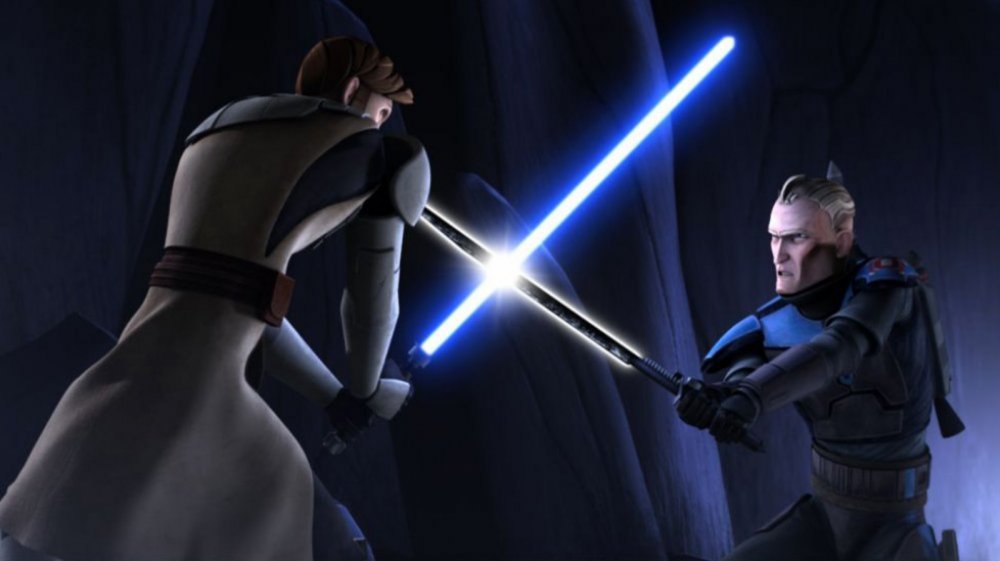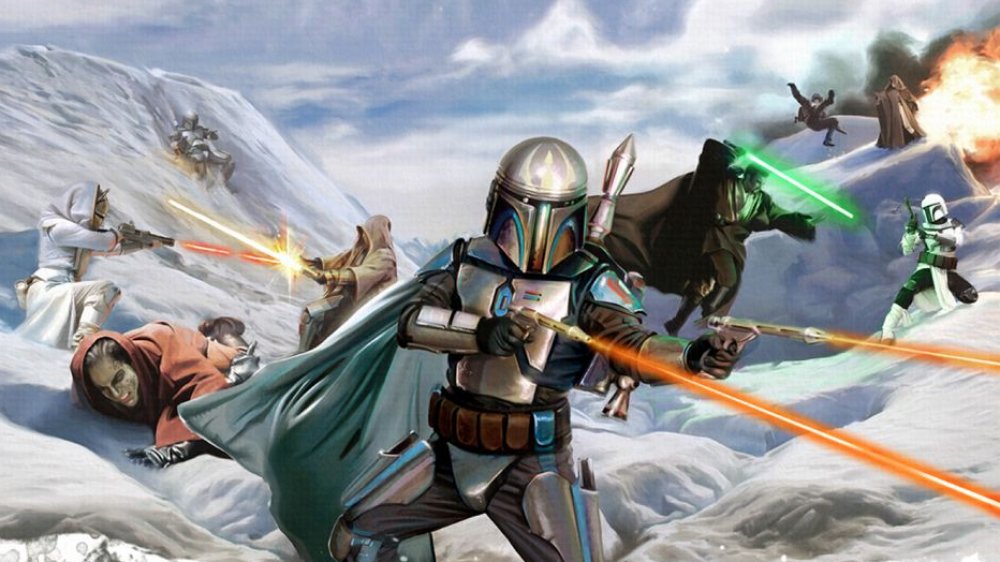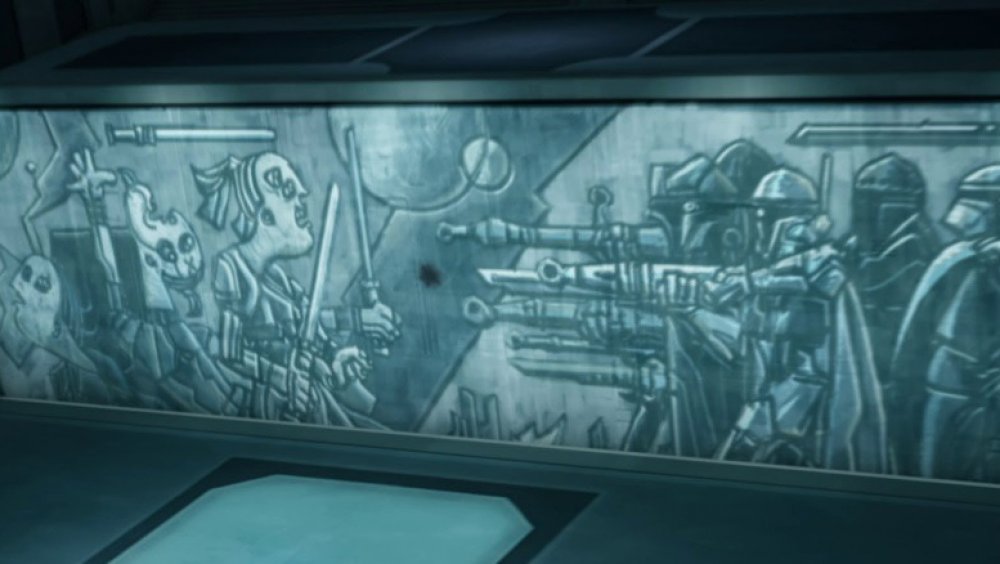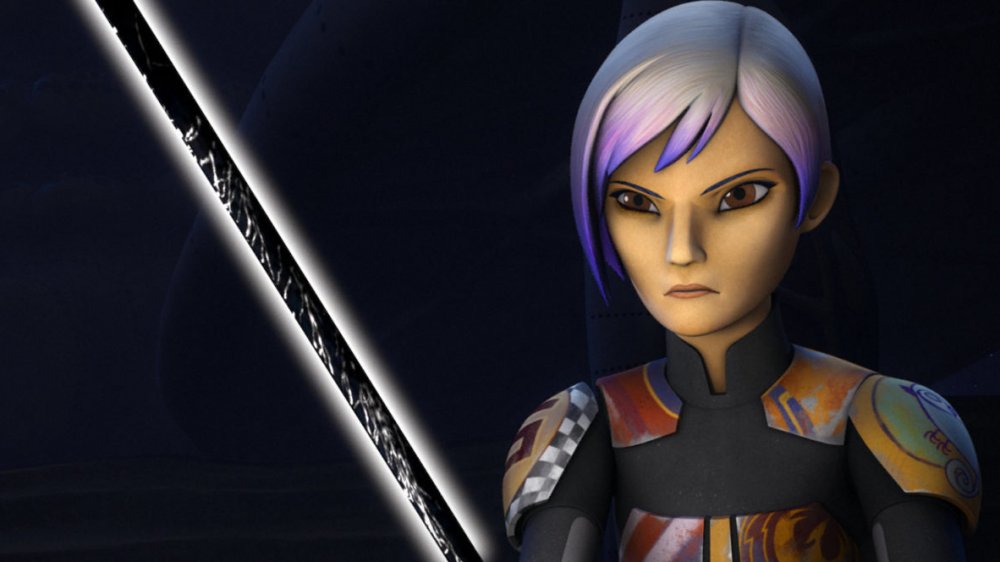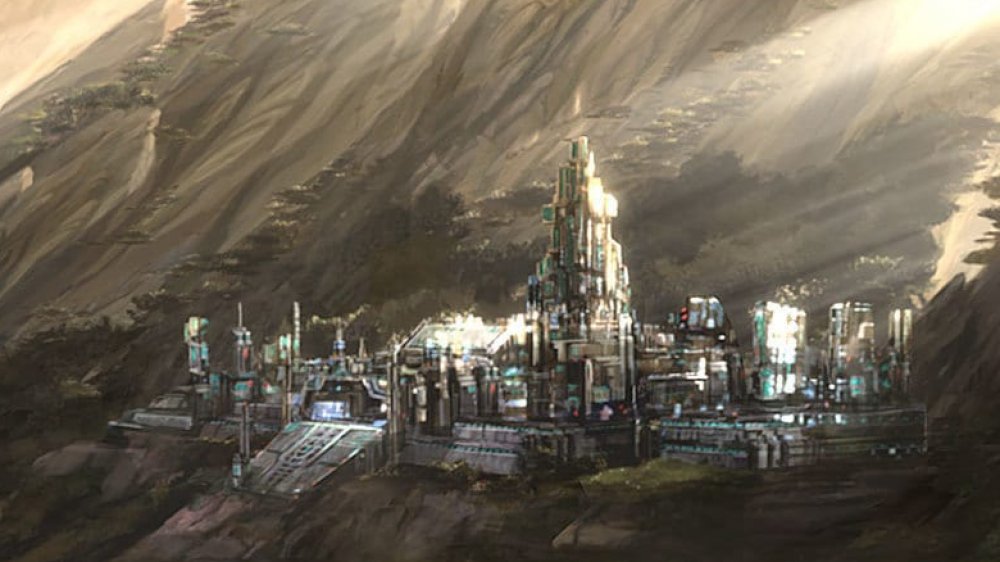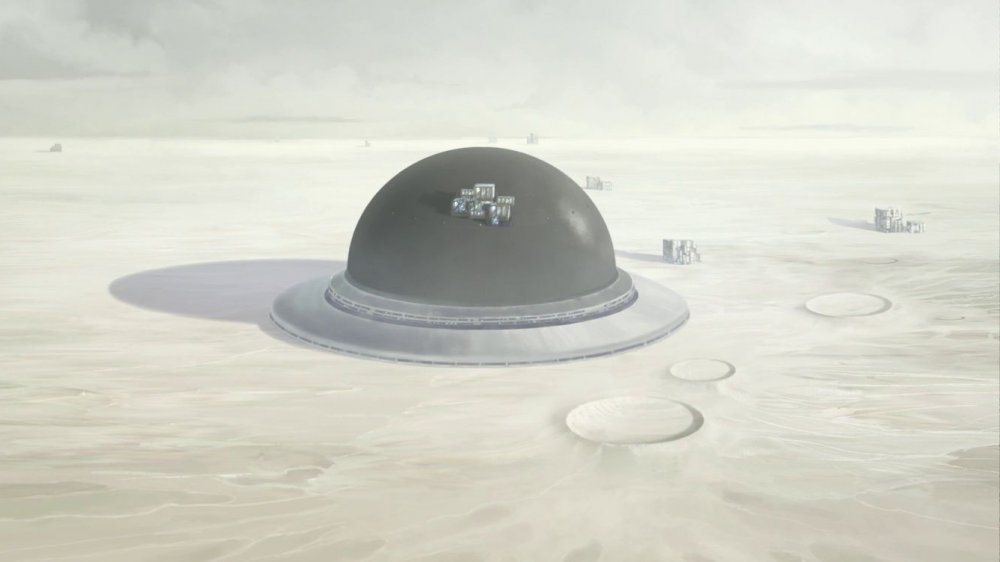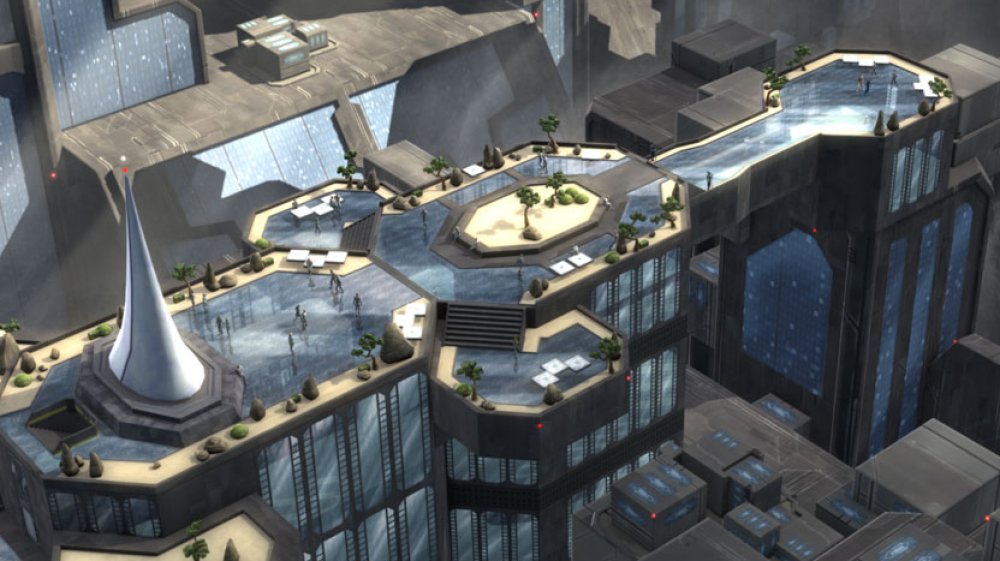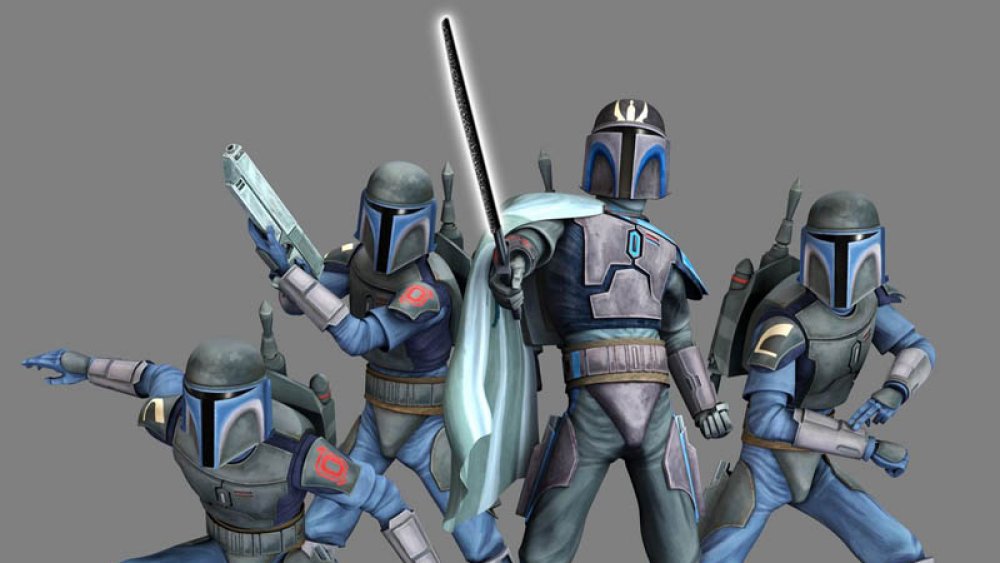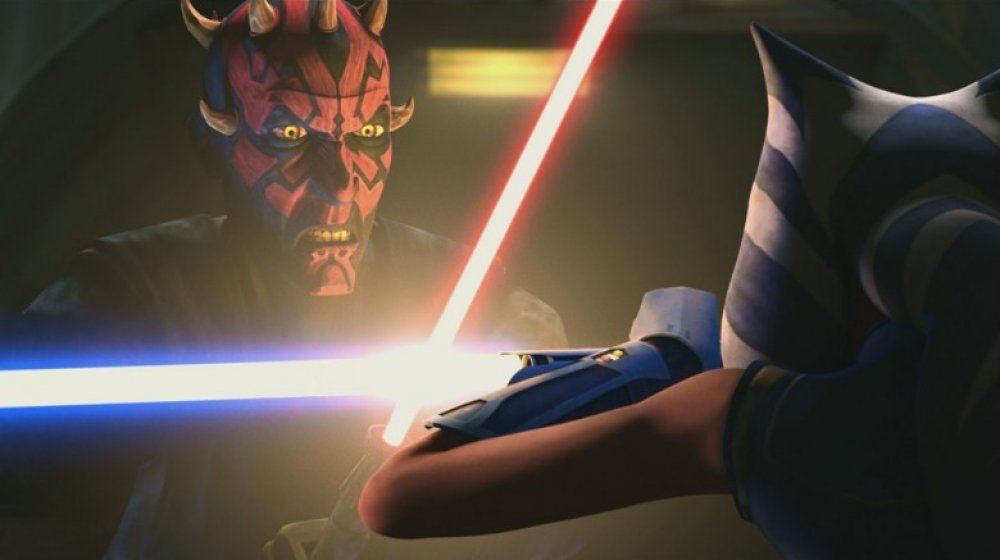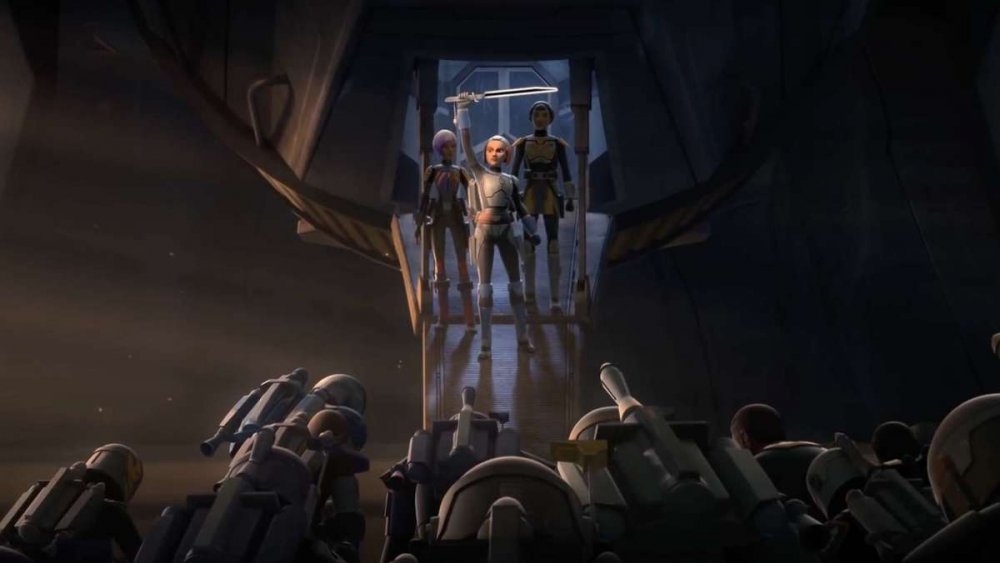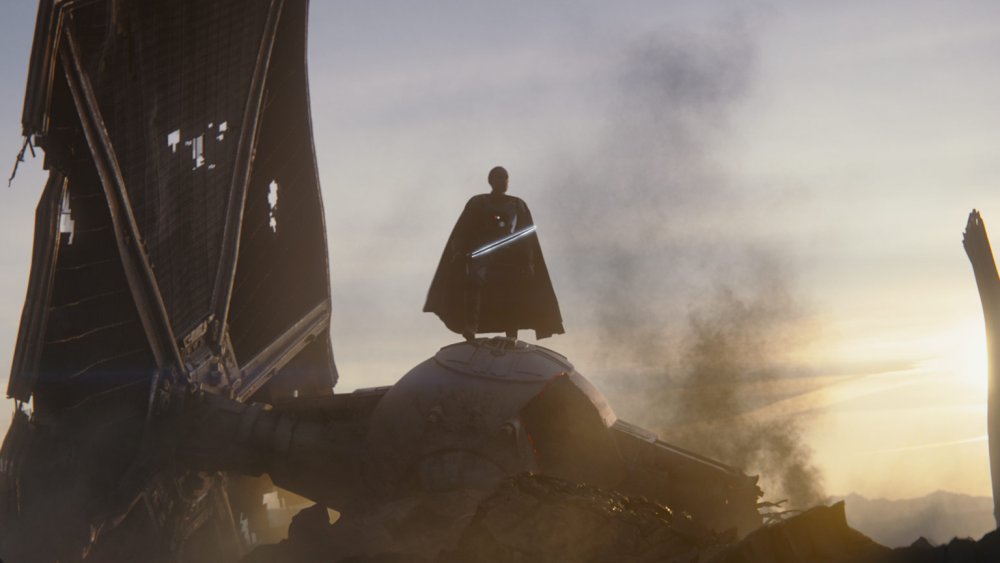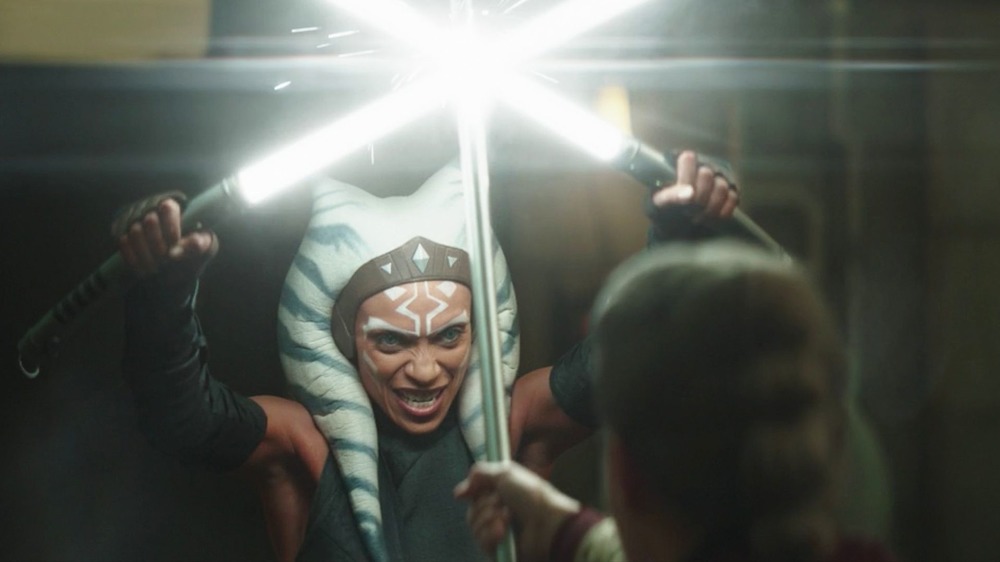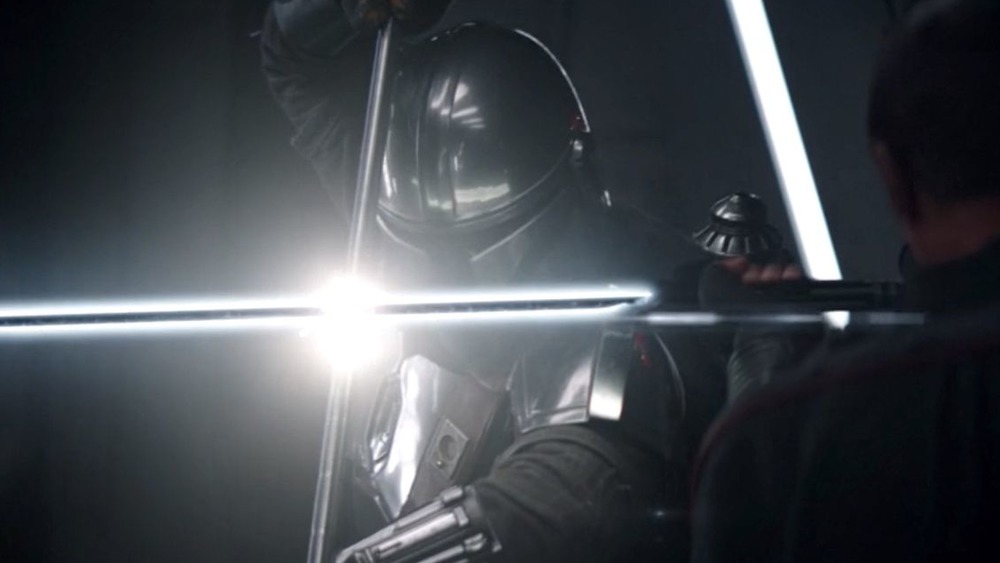The History Of The Mandalorian-Jedi War Explained
The Mandalorian creed has some of the most interesting mythology in the Star Wars universe. For starters, much of this intergalactic clan don unique armor and are skilled combatants. Although this organization originated from the planet Mandalore, their members include many species from all over the galaxy. Funnily enough, the first "Mandalorian" to ever appear in a Star Wars movie, Boba Fett, was not a Mandalorian at all but rather a bounty hunter who just so happened to wear Mandalorian armor.
Nevertheless, Disney and Lucasfilm have expanded upon the Mandalorian mythos through books, comics, and even television. One such event that is gaining more traction is the Mandalorian-Jedi War. This long-running series of conflicts between the Mandalorians and the Jedi was a major part of the video game Knights of the Old Republic, which, unfortunately, is no longer canon. Thankfully, producer Dave Filoni has slowly but surely reintroduced the Mandalorian-Jedi War into the current canon. Although much of the information about this war is still up in the air, this article will highlight all the currently known details about the Mandalorian-Jedi War as well as how it affected later events in the Star Wars universe.
Spoilers for Star Wars: The Clone Wars, Star Wars Rebels, and The Mandalorian to follow.
The cause of the Mandalorian-Jedi War
As odd as it sounds, the war started because the Mandalorians did not understand the Jedi when they first encountered them. Even at the end of The Mandalorian season 1, the Armorer described the Jedi as "an order of sorcerers."
Due to this lack of understanding, the Mandalorians created weapons and armor to better combat these mysterious new opponents. In 2017, Comicbook.com interviewed Filoni about how the Star Wars: Rebels episode "Trials of the Darksaber" referenced the Mandalorian-Jedi War, to which he explained, "The Mandalorian-Jedi War that I have in my mind is very much derived from the oldest style of thinking of Mandalorians, which was that their weapons, their arsenal, their technology had a massive increase once they collided with the Jedi and found these force-wielding people that had abilities they didn't understand." As bad as war is, it did help develop the Manadalorians into the badasses they're now known as.
The Mandalorian Crusades
More and more animosity occurred between the Mandalorians and Jedi once the latter group started interfering with the former's crusades. The 2016 reference book Star Wars: Aliens of the Galaxy details how a group of sword-wielding Mandalorians known as the Mandalorian crusaders carried out a series of crusades across the galaxy. While in the Inner Rim, the crusaders devastated a planet called Ubduria out of contempt for the native Ubdurians, who they viewed as dishonorable cowards. The Mandalorian crusaders also fought the Jedi at some point, although not much is known about these battles as of this moment.
Fortunately, cubist murals of the Mandalorian crusaders fighting the Jedi were created during the crusades and can be seen in three episodes from Star Wars: The Clone Wars ("The Mandalore Plot," "Shades of Reason," and "The Lawless") as well as one episode of Star Wars: Rebels ("Voices and Visions"). Although Pablo Picasso popularized the cubist art style in real life, it underwent a popular resurgence among Mandalorians during the Clone Wars. Who knew that some of the fiercest warriors in the galaxy had an eye for culture?
The Darksaber
Even though Mandalorians and Jedi were at one point sworn enemies, a member of the former group did create a lightsaber of his own. That member was Tarre Vizsla, the first Mandalorian ever inducted into the Jedi Order. Tarre created a unique black-colored lightsaber called the Darksaber during his time as a Jedi. After he died, the Jedi kept the saber in the Jedi Temple, but during the fall of the Old Republic, members of House Vizsla raided that temple and reclaimed the saber. They used it to unite their people and defeat anyone who opposed them, including Jedi.
The Darksaber would become a symbol of power to the Mandalorians and was used to unite them before and after the Mandalorian-Jedi War. In Star Wars: Rebels (the second CG-animated series from Dave Filoni), Sabine Wren would use the saber to unite her people against the Empire. As if the Mandalorians weren't already cool enough.
Concordia
The Mandalorian-Jedi War became so heated that the former side had to create a mining base on their own moon. Near the end of their wars, the Mandalorians turned Concordia, the moon of their homeworld, into a mining base. These mines almost destroyed the moon's forests, but once the Mandalorians stopped fighting, their forests started to grow back. By the time of the Clone Wars, all of Mandalore's warriors were exiled to Concordia, where they presumably died off. Around that time, Concordia had become a providence of Mandalore complete with it its own governor, Pre Vizsla. Although Pre pledged loyalty to Mandalore's duchess, Satine Kryze, he secretly used the abandoned mines to lead a splinter group called Death Watch.
Concidentally, Pre Vizsla was voiced by Jon Favreau, who would go on to create The Mandalorian live-action series for Disney+. Favreau wanting to expand the Mandalorian mythos actually makes more sense than one would imagine. In 2019, CinemaBlend interviewed Filoni and Favreau about working together on The Clone Wars. After getting a sneak peek of the first season while it was still in production, Favreau asked Filoni if he needed a voice actor for the next season. Filoni told Favreau that he needed someone to voice a Mandalorian named Pre Vizsla, to which Favreau replied, "Mandalorians were my favorite characters. I mean, if you're gonna play anything."
The devastation of Mandalore
Although the Mandalorians must have put up a good fight against the Jedi, it was not enough to save their homeworld. The Mandalorian-Jedi War ended with a final battle, which caused a cataclysm that scorched much of Mandalore into a white, uninhabitable wasteland. The Jedi won the war, but not all was lost for the Mandalorians, as they created hermetically sealed domed cities on Mandalore's surface.
One such city was the capital city of Sundari, which has appeared in several episodes of The Clone Wars. When it was first introduced, this city looked beautiful and lively compared to the barren and neglected desert outside the city. Not much is known about exactly what caused the cataclysm, but in "Heroes of Mandalore," the two-part season 4 premiere of Star Wars: Rebels, Sabine explains, "Once upon a time, these plains were covered with grass, but I never saw it. This destruction happened before I was born." Hopefully, we'll learn more details about this disastrous final battle between the Mandalorians and the Jedi.
The New Mandalorians
After the Mandalorian-Jedi War ended, many Mandalorians, including soon-to-be-duchess Satine Kryze, did not want continue the cycle of violence that almost destroyed their planet and, in turn, formed a peaceful movement called the New Mandalorians. Forty-two years before the Battle of Yavin, a civil war broke out between the New Mandalorians and the martial traditionalists who both sought control for Mandalore.
The death toll during this war was a primary reason why Satine became a pacifist for the rest of her life. As duchess, Satine rebuilt Mandalore, and it thrived under her leadership for 20 years. Keldabe, the planet's original capital, was ravaged during the first Mandalorian Civil War, so the New Mandalorians moved the capital to Sundari, which became their center of influence. Unfortunately, not all of the government officials were as trustworthy as Satine initially believed. In fact, the Clone Wars episode "The Academy" reveals that Prime Minister Almec established a black market trade network on Mandalore behind the duchess' back. Nevertheless, Satine always stayed true to her ideals even in the face of danger.
Mandalore went on to become an active participant in the senate of the Galactic Republic yet still remained neutral throughout the majority of the Clone Wars. They even erected a memorial to commemorate the victims of Mandalore's violent past in the form of a public shrine on Sundari called Peace Park. To quote the opening text in "The Mandalore Plot," "If you ignore the past, you jeopardize your future."
Death Watch
Of course, many Mandalorians still opposed the New Mandalorians' pacifist ideals and wanted to return Mandalore to its warrior ways. These same Mandalorians would go on to form the terrorist organization Death Watch under the leadership of Governor Pre Vizsla and Satine's sister, Bo-Katan Kryze. Death Watch was initially aligned with Count Dooku and the Separatists, but they parted ways and eventually joined forces with a renegade Sith lord named Maul to take over Mandalore together.
With the help of Maul's brother, Savage Opress, and several crime syndicates, Maul and Vizsla devised a plan to make the New Mandalorians look weak in order to gain the people's trust. The plan was successfully carried out, and Vizsla declared himself ruler of Mandalore, but he betrayed Maul and imprisoned him with his brother. It didn't take long for the brothers to escape, however, and Maul challenged Vizsla to a duel, which he won. After beheading Vizsla with the Darksaber, Maul declared himself the new leader of Death Watch and reinstalled Almec as prime minister of Mandalore while he ruled from the shadows. Even though The Clone Wars was originally released on Cartoon Network, scenes such as this are why it was primarily aimed at ages ten and up.
The Shadow Collective
Upon usurping Pre Vizsla as ruler of Mandalore, Maul gained much of Death Watch's loyalty, but some members, such as Bo-Katan, could not accept the idea of an outsider ruling Mandalore and led a resistance against him. Maul's loyal Death Watch followers, along with the criminal organizations he recruited (Black Sun, the Pykes, and even the Hutts), formed the base of his larger crime syndicate, the Shadow Collective. Unfortunately, this widespread union did not last for long, as Darth Sidious captured Maul and killed Savage in the process. Fortunately for Maul fans, the four-part comic book miniseries Star Wars: Darth Maul — Son of Dathomir sees the renegade Sith Lord escape from captivity with help of his loyal Death Watch followers.
In the seventh and final season of Star Wars: The Clone Wars, Maul regroups with the Pyke Syndicate and Black Sun, but their reunion is cut short, however, after former Jedi knight Ahsoka Tano and Bo-Katan team up to launch full-scale assault in an attempt to liberate Mandalore from the clutches of the Shadow Collective. Before ordering the other Shadow Collective leaders to go into hiding, Maul is captured but subsequently escapes custody in the wake of Order 66.
The 2018 spinoff film Solo: A Star Wars Story, set after the events of The Clone Wars season 7, reveals that Maul established another crime syndicate called the Crimson Dawn, a revelation that will hopefully be expanded upon in future canon stories.
Mandalorian resistance
Even though Bo-Katan and her forces defeated Maul and freed Mandalore from the Shadow Collective, it did not take long for the Empire to undo all that progress. In the two-part season 4 premiere of Star Wars: Rebels, Bo-Katan reveals that she refused to comply with the imperial occupation of her homeworld, which led Clan Saxon to betray her and swear allegiance to Emperor Palpatine. Fortunately, Bo-Katan joined forces with Clan Wren, the Mandalorian Protectors, and members of the Rebel Alliance to fight back against Clan Saxon and destroy the Arc Pulse Generator superweapon that Tiber Saxon, the Imperial governor of Mandalore, almost used to wipe out the Mandalorian resistance. Following this victory, Bo-Katan was given the Darksaber and took up the title of Mand'alor, a title assumed by the sole leader of the Mandalorian people.
Unfortunately, the Empire would strike back against the remaining Mandalorians in the form of the Great Purge. As explained in The Mandalorian season 1, this event saw the deaths of many Mandalorians across the galaxy and the Empire stealing massive amounts of beskar, a metal alloy that Mandalorians use to create their signature armor.
Bo-Katan and the Darksaber
The Mandalorian season 2 expands what viewers know about the Mandalorian-Jedi War with a few key characters and moments of insight.
In the season 1 finale, the Tribe's Armorer tells Mando, a.k.a. Din Djarin (Pedro Pascal), about how Mandalore the Great fought against enemy sorcerers called Jedi and that he needs to reunite the Child, or Baby Yoda as he is known on the interwebs, with his people. That mission sends Mando on a series of side quests, including one that puts him in direct contact with Bo-Katan (Katee Sackhoff) and her fellow Mandalorian separatists, Koska Reeves (Mercedes Varnado) and Axe Woves (Simon Kassianides). Although they don't share Djarin's rigid adherence to the Mandalorian creed — one of the first things they do onscreen is remove their helmets — Bo-Katan ultimately helps him on his mission, in exchange for his help in raiding an Imperial ship.
Mando is initially led to believe the separatists are simply trying to steal weapons from the shattered Empire, but it eventually becomes clear that Bo-Katan is really after the Darksaber, now wielded by Moff Gideon. Living up to her end of the deal, she tells Djarin where to find a Jedi, telling him to seek out Ahsoka Tano.
Ahsoka Tano and The Child
Acting on a tip from Bo-Katan, Mando heads to the planet Corvus, a deforested wasteland where the audience sees Ahsoka Tano (played by Rosario Dawson) waging a one-Jedi war against the brutal reign of a figure known as the Magistrate (Diana Lee Inosanto). Upon Mando's arrival, he's shepherded to an audience with the Magistrate, who offers him a staff made of pure beskar in exchange for murdering Ahsoka. To his credit, he has no intention of doing anything of the kind — as he quickly convinces Ahsoka following a brief skirmish when they meet in the Corvus wastelands.
Pressed into yet another side quest in order to fulfill his mission, Mando offers to help Ahsoka defeat the Magistrate in exchange for her accepting and training the Child — a union that he quips "they'll never see coming," given the widespread antipathy between Mandalorian and Jedi. As expected, the Magistrate is no match for the duo, but in Ahsoka's final battle against her, she's separated from Mando — which is why he doesn't hear her demand to know the location of the Magistrate's master, Grand Admiral Thrawn.
Ultimately, Ahsoka is unable to live up to her end of the deal, telling Mando that she can't train the Child. She's able to speak with him via the Force, and learns that his real name is Grogu — and that he was trained on Coruscant before being taken during the fall of the Jedi. But she also discovers a great deal of fear, anger, and darkness in him, and having been close to Anakin Skywalker, she's all too aware of how those feelings can be exploited.
Din Djarin: Ruler of Mandalore
Although Ahsoka is unable or unwilling to train Grogu, she offers Mando one other way to fulfill his obligation — take him to the planet Tython, where Grogu may be able to tap into the Force at the site of some ancient temple ruins and establish a connection with another Jedi. In the middle of that process, however, Grogu is intercepted by Moff Gideon's Dark Troopers. Mando teams up with Boba Fett, Fennec Shand, Cara Dune, Bo-Katan, and Koska Reeves to overtake Gideon's light cruiser and save the Child.
Upon reaching Grogu's cell, Mando sees Gideon holding the Darksaber over Grogu. Even though Gideon says that Mando can have the Child, he proceeds to attack him with the Darksaber and the two engage in a duel. In the end, Mando disarms Gideon with the beskar spear he received from Ahsoka back on Corvus.
After taking Grogu and a shackled Gideon to the bridge, Mando offers the Darksaber to Bo-Katan, but she refuses. That's when Gideon remarks that the Darksaber cannot be given and must be won in combat, which Bo-Katan acknowledges as the truth. Their stand-off is interrupted when a Jedi — Luke Skywalker himself (Mark Hamill) — arrives to rescue them from a squad of Dark Troopers and take Grogu away to be trained.
The second season of The Mandalorian leaves the fate of the Darksaber and the leadership it represents in a precarious position. Of course, if it can't be given willingly, why did Bo-Katan accept it from Sabine Wren during the events of Rebels? Hopefully, all these questions and more will be answered in The Mandalorian season 3.
